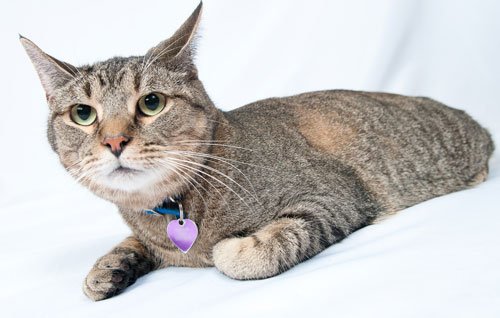How Do I Know if My Cat is in Pain?

My cat is getting older, and I want to be sure to take care of her the best I can. People eventually develop arthritis and pain as they age, and I understand the same thing happens in cats. How can I recognize if my cat is becoming painful so that I can bring it to the attention of my veterinarian?
Recognizing and treating pain in cats has evolved dramatically over time. We understand that because cats are living longer and longer, they are also experiencing the deterioration and debilitation that go along with aging. This includes the development of osteoarthritis, which involves painful inflammation of the joints. It is a cat’s instinct to hide or mask its pain, making pain difficult to diagnose. Pain cannot be treated unless and until it is unmasked. No one is in a better position to identify the subtle changes in behavior that may signal pain than human family members. When a cat is experiencing pain, the following are changes that you may notice, and these signal the need to visit your veterinarian:
Vocalizing
You may notice your cat meowing more than normal. You may also hear her purring at times you would not normally expect it. She may also growl or hiss when approached by human family members or by other animal members of the family.
Changes in activities of daily living
You may notice pacing or restlessness because your cat cannot find a comfortable place to lie down. Likewise, she may repeatedly get up and lie down in an attempt to find a comfortable position. You may notice she has less energy or decreased stamina to engage in previously enjoyable activities such as chasing toys or play-hunting. Her rear legs may tremble when standing still or at rest. She may become reluctant to go up or down stairs. You may notice she no longer jumps up onto furniture, cat trees, or window sills. You may notice a limp. Finally, she may develop an aversion to walking on slick floor surfaces.
Changes in daily habits
“Cats who are painful may withdraw from their usual family interactions, may become less engaged in their surroundings, and may start hiding.”
Most cats who develop painful osteoarthritis stop grooming themselves as well as usual. They develop an unkempt hair coat, and may become matted over their painful body parts. Some painful cats will actually over-groom and traumatize the skin of the affected areas. Cats who are painful may withdraw from their usual family interactions, may become less engaged in their surroundings, and may start hiding. You may notice decreased eating and/or drinking. You may also notice changes in sleeping patterns – some may sleep more, while others may sleep less, they may sleep in an unusual position, or they may sleep in odd places. Some painful cats have lapses in litterbox use because it is uncomfortable to get into and out of the litterbox. They may have difficulty squatting, and consequently urinate over the edge of the litterbox.
Changes in facial expressions
Cats who are painful may develop a facial expression that could be described as a grimace. They may seem to have a vacant stare off into space. Some painful cats actually have a wide-eyed look. These cats may also squint their eyes or appear to be half asleep.
Uncharacteristic aggression
“She may growl, or hiss when people or other pets in the household approach them. “
A painful cat who has previously been very friendly and gentle may begin to act completely out of character. She may growl, or hiss when people or other pets in the household approach them. She may lash out if handled, and may resent being brushed or combed. She may appear to have a very defensive posture when simply lounging around the house, watching carefully what is happening around her in order to avoid painful encounters. She may resent and avoid being picked up and held.
Abnormal postures
A painful cat may stand with her front legs back under her chest in order to take some of the weight away from painful hips or rear legs. You may notice that once she lies down she keeps her legs tucked up underneath her instead of stretching out on her side. She may avoid or have difficulty engaging in scratching behaviors. She may stop the characteristic stretching that cats generally perform.
Any or all of these changes may indicate pain, and should be brought to the attention of your veterinarian. We now understand that the sooner we recognize pain and begin managing it, the better we can maintain excellent quality of life, as well as maintaining your cat’s (and the family’s) activities of daily living.
Robin Downing, DVM, DAAPM, DACVSMR, CVPP, CRPPCourtesy of LifeLearn Inc. Used and/or modified with permission under license.
- Behavior (12)
- Caring for your pet (266)
- cat (6)
- Community Events (19)
- dog (7)
- From Our Clients (15)
- Happy Tails (9)
- News (424)
- Press (53)
- Products (2)
- Questions (4)
- Recalls (1)
- Special Offers (5)
- Tips & Advice (231)
- Uncategorized (19)
- Veterinary Services (48)
